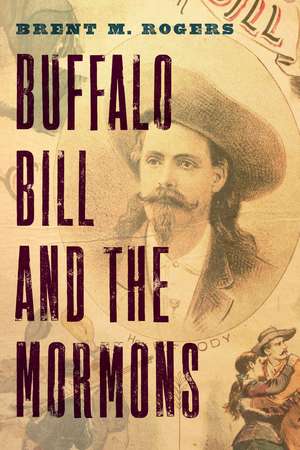Buffalo Bill and the Mormons
Autor Brent M. Rogersen Limba Engleză Paperback – 29 feb 2024
In Buffalo Bill and the Mormons Rogers unravels this history and the fascinating trajectory that took America’s most famous celebrity from foe to friend of the Latter-day Saints. In doing so, the book demonstrates how the evolving relationship between Cody and the Latter-day Saints can help readers better understand the political and cultural perceptions of Mormons and the American West.
Preț: 158.98 lei
Nou
Puncte Express: 238
Preț estimativ în valută:
30.42€ • 31.91$ • 25.37£
30.42€ • 31.91$ • 25.37£
Carte disponibilă
Livrare economică 17-31 decembrie
Preluare comenzi: 021 569.72.76
Specificații
ISBN-13: 9781496213181
ISBN-10: 1496213181
Pagini: 312
Ilustrații: 22 photographs, 7 illustrations, 1 map, index
Dimensiuni: 152 x 226 x 26 mm
Greutate: 0.48 kg
Editura: U.S. Holocaust Memorial Museum
Locul publicării:United States
ISBN-10: 1496213181
Pagini: 312
Ilustrații: 22 photographs, 7 illustrations, 1 map, index
Dimensiuni: 152 x 226 x 26 mm
Greutate: 0.48 kg
Editura: U.S. Holocaust Memorial Museum
Locul publicării:United States
Notă biografică
Brent M. Rogers is a historian and the managing historian for the Joseph Smith Papers. He is the author of Unpopular Sovereignty: Mormons and the Federal Management of Early Utah Territory (Nebraska, 2017), winner of the 2018 Charles Redd Center–Phi Alpha Theta Book Award for the Best Book on the American West, and the coeditor of Contingent Citizens: Shifting Perceptions of Latter-day Saints in American Political Culture.
Cuprins
List of Illustrations
Acknowledgments
A Note on Style
Act I
Introduction: Buffalo Bill Greets the Saints
1. Setting the Stage
2. Buffalo Bill and the Mormons on the Stage
3. A Scene Change
4. Buffalo Bill and the Mormons on the World’s Stage
Act II
5. Negotiating Opportunities
6. The Saints Settle Cody Country
7. Friends in the End
Conclusion: Curtain Call
Notes
Bibliography
Index
Acknowledgments
A Note on Style
Act I
Introduction: Buffalo Bill Greets the Saints
1. Setting the Stage
2. Buffalo Bill and the Mormons on the Stage
3. A Scene Change
4. Buffalo Bill and the Mormons on the World’s Stage
Act II
5. Negotiating Opportunities
6. The Saints Settle Cody Country
7. Friends in the End
Conclusion: Curtain Call
Notes
Bibliography
Index
Recenzii
"Rogers' (Unpopular Sovereignty, 2017) uniquely focused narrative of Cody's turnabout will attract fans of Old West life unfamiliar with this tale of show business and history."—Booklist
“In this carefully researched book, Brent Rogers traces the surprisingly entangled and little-known stories of William F. ‘Buffalo Bill’ Cody and The Church of Jesus Christ of Latter-day Saints. A remarkable history of how two western forces, famed showman and fabled church, mythologized each other.”—Louis S. Warren, author of Buffalo Bill’s America: William Cody and the Wild West Show
“By asking a seemingly simple question—what were Buffalo Bill’s ties to the Latter-day Saints?—Rogers offers a fascinating new perspective on the life and career of William F. Cody. Situated within the political and religious angst about Mormon polygamy in post–Civil War America, Rogers’s extensive research and sharp analysis bring to life Cody’s complicated and evolving connection to the Latter-day Saints.”—Renée M. Laegreid, professor of western history at the University of Wyoming
“The American West was a gathering place for all sorts. Through lyrical prose and impressive research Brent Rogers has excavated the revealing—and often surprising—intersections between two cultural forces: Buffalo Bill and the Mormons. But beyond separating fact from fiction, this book captures some of the central tensions of a culture enmeshed in the paradoxes of colonization.”—Benjamin E. Park, author of American Zion: A New History of Mormonism
Descriere
Brent M. Rogers connects the histories of William F. “Buffalo Bill” Cody and the Mormons, highlighting two pillars of the American West to better understand cultural and political perceptions, image-making, and performance from the 1840s through the early 1900s.
